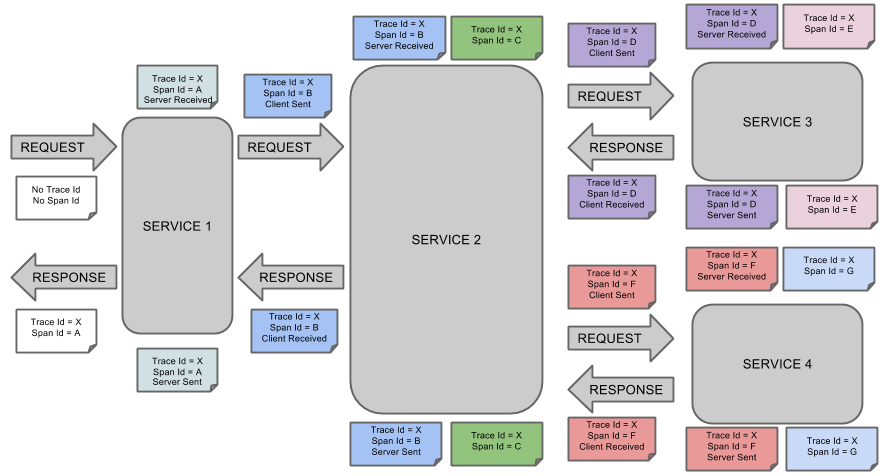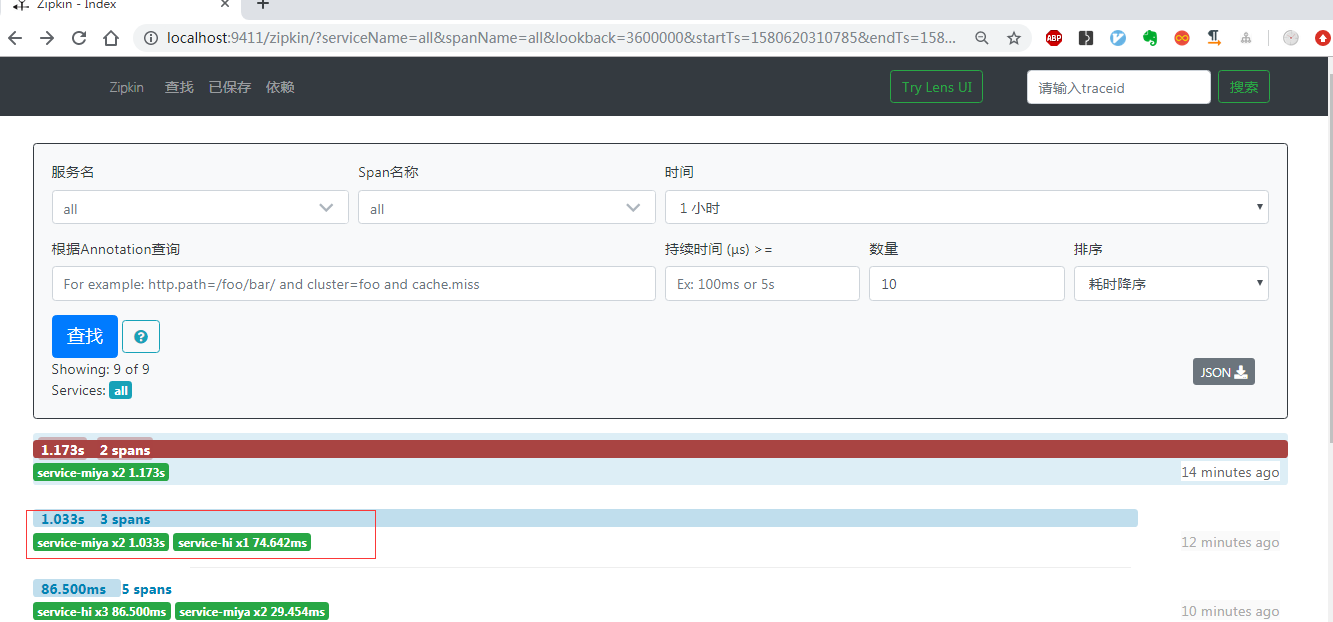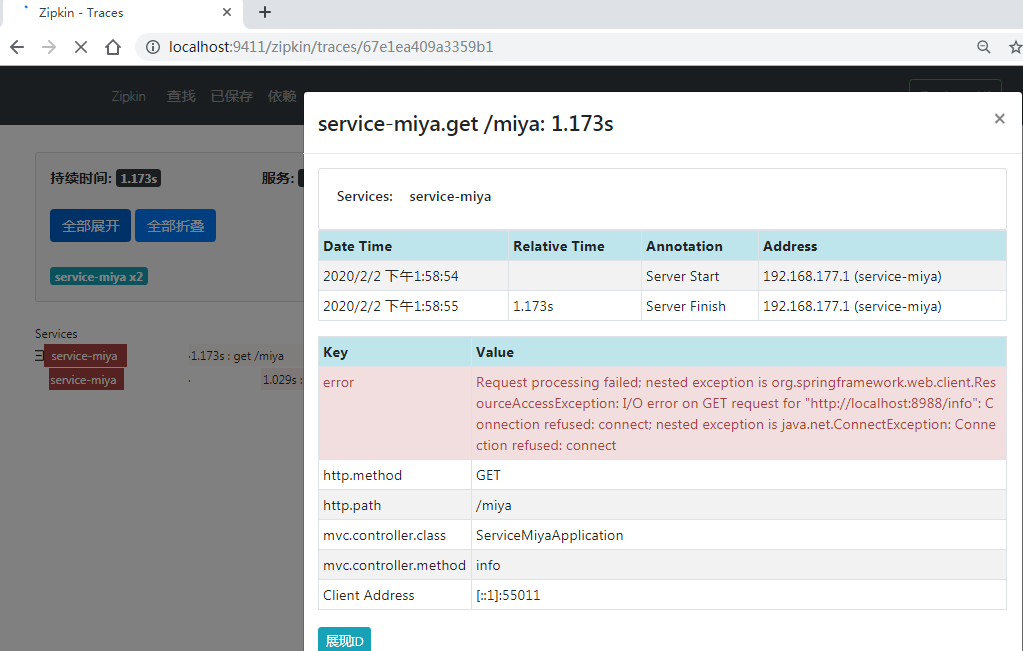(六)Spring Cloud教程——Sleuth(F版本)
参考:方志朋的专栏
1. 简介
微服务架构上通过业务来划分服务的,通过REST调用,对外暴露的一个接口,可能需要很多个服务协同才能完成这个接口功能,如果链路上任何一个服务出现问题或者网络超时,都会导致接口调用失败。随着业务的不断扩张,服务之间互相调用会越来越复杂。随着服务的越来越多,对调用链的分析会越来越复杂。
Spring Cloud Sleuth服务链路跟踪功能就可以帮助我们快速的发现错误根源以及监控分析每条请求链路上的性能等等。
相关术语:
- Span:基本工作单元,例如,在一个新建的span中发送一个RPC等同于发送一个回应请求给RPC,span通过一个64位ID唯一标识,trace以另一个64位ID表示,span还有其他数据信息,比如摘要、时间戳事件、关键值注释(tags)、span的ID、以及进度ID(通常是IP地址) span在不断的启动和停止,同时记录了时间信息,当你创建了一个span,你必须在未来的某个时刻停止它。
- Trace:一系列spans组成的一个树状结构,例如,如果你正在跑一个分布式大数据工程,你可能需要创建一个trace。
- Annotation:用来及时记录一个事件的存在,一些核心annotations用来定义一个请求的开始和结束
- cs - Client Sent -客户端发起一个请求,这个annotion描述了这个span的开始
- sr - Server Received -服务端获得请求并准备开始处理它,如果将其sr减去cs时间戳便可得到网络延迟
- ss - Server Sent -注解表明请求处理的完成(当请求返回客户端),如果ss减去sr时间戳便可得到服务端需要的处理请求时间
- cr - Client Received -表明span的结束,客户端成功接收到服务端的回复,如果cr减去cs时间戳便可得到客户端从服务端获取回复的所有所需时间
如果一个服务的调用关系如下:

那么此时将Span和Trace在一个系统中使用Zipkin注解的过程图形化:

2. 构建工程
本文的案例主要有三个工程组成:一个server-zipkin,它的主要作用使用ZipkinServer 的功能,收集调用数据,并展示;一个service-hi,对外暴露hi接口;一个service-miya,对外暴露miya接口;这两个service可以相互调用;并且只有调用了,server-zipkin才会收集数据的,这就是为什么叫服务追踪了。
2.1 构建server-zipkin
在Spring Cloud为F版本的时候,已不需要自己构建Zipkin Server了,只需要下载jar即可,下载地址:https://dl.bintray.com/openzipkin/maven/io/zipkin/java/zipkin-server/ 。
下载完毕,执行命令运行
java -jar zipkin-server-2.12.9-exec.jar
访问:localhost:9411

2.2 创建service-hi
通过引入spring-cloud-starter-zipkin依赖和设置spring.zipkin.base-url即可,步骤如下:
在其pom引入起步依赖spring-cloud-starter-zipkin:
<dependency> <groupId>org.springframework.cloud</groupId> <artifactId>spring-cloud-starter-zipkin</artifactId> </dependency>
在其配置文件application.yml指定zipkin server的地址,头通过配置“spring.zipkin.base-url”指定:
server.port=8988
spring.application.name=service-hi
spring.zipkin.base-url=http://localhost:9411
对外暴露接口:
import brave.sampler.Sampler; import org.springframework.beans.factory.annotation.Autowired; import org.springframework.boot.SpringApplication; import org.springframework.boot.autoconfigure.SpringBootApplication; import org.springframework.context.annotation.Bean; import org.springframework.web.bind.annotation.RequestMapping; import org.springframework.web.bind.annotation.RestController; import org.springframework.web.client.RestTemplate; import java.util.logging.Level; import java.util.logging.Logger; @SpringBootApplication @RestController public class ServiceHiApplication { public static void main(String[] args) { SpringApplication.run(ServiceHiApplication.class, args); } private static final Logger LOG = Logger.getLogger(ServiceHiApplication.class.getName()); @Autowired private RestTemplate restTemplate; @Bean public RestTemplate getRestTemplate(){ return new RestTemplate(); } @RequestMapping("/hi") public String callHome(){ LOG.log(Level.INFO, "calling trace service-hi "); return restTemplate.getForObject("http://localhost:8989/miya", String.class); } @RequestMapping("/info") public String info(){ LOG.log(Level.INFO, "calling trace service-hi "); return "i'm service-hi"; } @Bean public Sampler defaultSampler() { return Sampler.ALWAYS_SAMPLE; } }
2.3 创建service-miya
创建过程同service-hi,引入相同的依赖,配置下spring.zipkin.base-url。
对外暴露接口:
import brave.sampler.Sampler; import org.springframework.beans.factory.annotation.Autowired; import org.springframework.boot.SpringApplication; import org.springframework.boot.autoconfigure.SpringBootApplication; import org.springframework.context.annotation.Bean; import org.springframework.web.bind.annotation.RequestMapping; import org.springframework.web.bind.annotation.RestController; import org.springframework.web.client.RestTemplate; import java.util.logging.Level; import java.util.logging.Logger; @SpringBootApplication @RestController public class ServiceMiyaApplication { public static void main(String[] args) { SpringApplication.run(ServiceMiyaApplication.class, args); } private static final Logger LOG = Logger.getLogger(ServiceMiyaApplication.class.getName()); @RequestMapping("/hi") public String home(){ LOG.log(Level.INFO, "hi is being called"); return "hi i'm miya!"; } @RequestMapping("/miya") public String info(){ LOG.log(Level.INFO, "info is being called"); return restTemplate.getForObject("http://localhost:8988/info",String.class); } @Autowired private RestTemplate restTemplate; @Bean public RestTemplate getRestTemplate(){ return new RestTemplate(); } @Bean public Sampler defaultSampler() { return Sampler.ALWAYS_SAMPLE; } }
3. 追踪服务调用
依次启动上面的工程,此时测试几次调用:如访问:http://localhost:8989/miya 或 http://localhost:8988/hi,浏览器出现:

此时访问http://localhost:9411/的界面,点击依赖,可以发现服务的依赖关系:

查找页面可对

点击具体服务调用,可以看到具体服务相互调用的数据。

查看服务详情,可跟踪其调用期间发生的问题。






【推荐】国内首个AI IDE,深度理解中文开发场景,立即下载体验Trae
【推荐】编程新体验,更懂你的AI,立即体验豆包MarsCode编程助手
【推荐】抖音旗下AI助手豆包,你的智能百科全书,全免费不限次数
【推荐】轻量又高性能的 SSH 工具 IShell:AI 加持,快人一步
· go语言实现终端里的倒计时
· 如何编写易于单元测试的代码
· 10年+ .NET Coder 心语,封装的思维:从隐藏、稳定开始理解其本质意义
· .NET Core 中如何实现缓存的预热?
· 从 HTTP 原因短语缺失研究 HTTP/2 和 HTTP/3 的设计差异
· 周边上新:园子的第一款马克杯温暖上架
· 分享 3 个 .NET 开源的文件压缩处理库,助力快速实现文件压缩解压功能!
· Ollama——大语言模型本地部署的极速利器
· DeepSeek如何颠覆传统软件测试?测试工程师会被淘汰吗?
· 使用C#创建一个MCP客户端